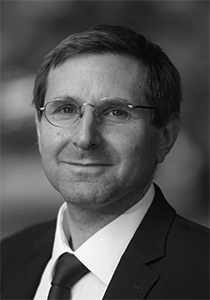Citation

We are pleased that AGU has recognized Thomas Hobiger’s achievements with the 2018 Geodesy Section Award. Thomas was educated at the Vienna University of Technology and received a Ph.D. in geodesy and geophysics in 2005. He took a postdoctoral position in Japan, rising to a senior researcher position at the National Institute of Information and Communications Technology. In 2014, he became a faculty member at Chalmers University of Technology; he moved to the University of Stuttgart in 2018 to lead the Institute for Navigation.
Thomas has worked in geodetic science and with geodetic engineering problems. The hallmark of his success is a thorough understanding of the error sources in both hardware and software systems, which has allowed him to conduct innovative research. While many geodesists focus on a single measurement system, his research portfolio is particularly broad, with studies in very long baseline interferometry (VLBI), the Global Navigation Satellite System (GNSS), satellite laser ranging (SLR), and interferometric synthetic aperture radar (InSAR). He has been a leader in GNSS reflectometry studies, in developing both software receivers and analysis tools for real-time applications. He has also contributed to the development of tools that allow the combination of disparate geodetic data at the observation level.
Thomas has also demonstrated a strong commitment to the international geodetic community by serving on committees and on editorial positions at Earth, Planets and Space and Journal of Geodesy. Prior to receiving the AGU Geodesy Section Award, Thomas was named an International Association of Geodesy (IAG) Fellow, received the Tsuboi Award, and was recognized by the European Geosciences Union with an outstanding young scientist award.
During his 4 years in our research group, Thomas contributed with a lot of energy and ideas. Although we will miss him, we wish him all the best for the future and congratulate him for this well-deserved award.
—Rüdiger Haas and Gunnar Elgered, Chalmers University of Technology, Gothenburg, Sweden
Response
I am very honored to receive the Geodesy Section Award, and I am deeply grateful to Rüdiger and Gunnar for their kind citation.
Being a geodesist by education and having worked in geodesy and neighboring disciplines have been very inspiring for me. I have learned from my colleagues and these neighboring fields, which has allowed me to apply this new knowledge to improve geodetic analysis and interpretation. AGU and its meetings have also been very important, as they bring together scientists in formal and, more important, informal levels.
Acknowledging everyone who has helped me to develop and grow would be impossible here, but I would like to mention a few people who have been very inspiring and who have pointed me in the right direction in my career. First, I would like to thank Dr. Kondo and Dr. Koyama for teaching me the instrumental side of geodesy and letting me explore things that are not usually the typical focus of geodesy. I would also like to acknowledge Dr. Hanado and her team for introducing me to neighboring fields and giving me the freedom to develop my own research topics. Being part of the Japanese geodetic community was a great experience that definitely shaped my research orientation.
Special thanks go to Rüdiger and Gunnar, who supported me at all times. They gave me the possibility to grow as a teacher, complementing my skills with a formal pedagogical education, and let me try different approaches in classroom and online education. I would like to thank Prof. Larson for teaching me how much fun it can be to be a geodesist, and special thanks go also to my Ph.D. and master’s students for enriching my views. Acknowledgments go also to all the people who provide data and products and build geodetic instruments for improving our understanding about our planet.
—Thomas Hobiger, Institute for Navigation, University of Stuttgart, Stuttgart, Germany
Citation:
(2018), Hobiger receives 2018 Geodesy Section Award, Eos, 99, https://doi.org/10.1029/2018EO108395. Published on 07 November 2018.
Text © 2018. The authors. CC BY-NC-ND 3.0
Except where otherwise noted, images are subject to copyright. Any reuse without express permission from the copyright owner is prohibited.
